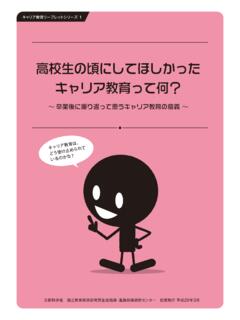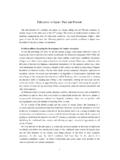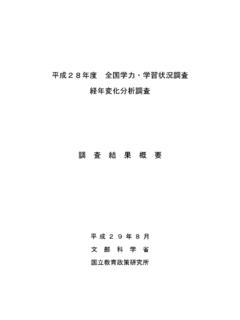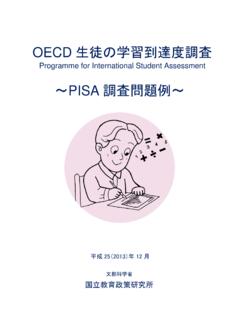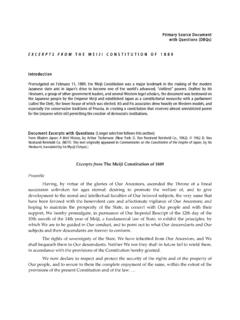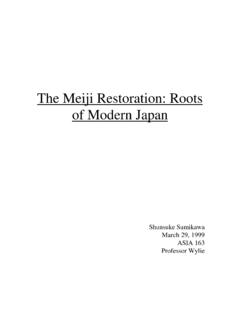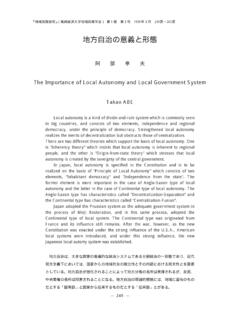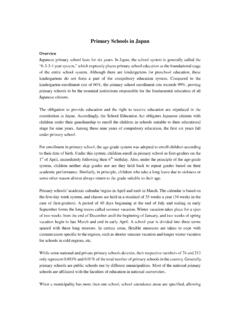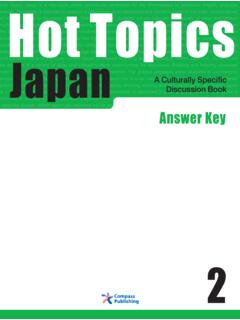Transcription of Moral Education in Japan
1 1 Moral Education in Japan Moral Education is included in school Education in many countries as values Education , citizenship Education , and religious Education , both formally and non-formally. Some countries have issues regarding the reasons for such Education activities in the formal sector1, but Japanese formal Education entails little discussion on this topic because the system has a national curriculum consisting of secular Central Council for Education , the ad-hoc advisory committee for the central Ministry of Education , Culture, Sports, Science and Technology (MEXT) pointed out in 2008 that Japanese children have a poor mind-set in terms of respect for life and self-esteem, and many of them lead an inappropriate lifestyle, while their normative consciousness is becoming lower and their inadequate social skills prevent them from forming good human relationships and participating in group activities.
2 The present Course of Studies, showing the minimum contents of the national curriculum, has aimed at enrichment and improvement of Moral Education for elementary schools since 2008 and secondary schools since 2009. This article illustrates the modern history, present situation, and issues of Moral Education in Japan . I. Brief History of Moral Education in Modern Japan I-1. From Nation-State Building to World War II (1873 - 1945) Elementary School Regulation (Shogaku Kyosoku) was issued in September 1873, and in the same year, the Educational System Ordinance (Gaku Sei), which included Oral Instruction on Morality called Shushin, was promulgated. This was the beginning of official Moral Education in Japanese Education . There were many direct translations from the Moral science found in the Western world then, but the story-telling3 method spread across the nation in Later, the Educational System Ordinance was abolished and replaced by the Education Order (Kyouiku Rei), and independent Shushin lessons were set separately from other subjects in 1879.
3 1 For example, the United States of America faces the issues of who should receive religious Education and how it is taught without a curriculum or textbooks. ( ) In Thailand, religious educators must also be keen analysts of social factors, even those that do not seem to be religious or spiritual in nature. It also means that religious educators must be critical interpreters of the truth and wisdom that are nurtured in faith/religion. ( ). 2 However, private schools can count religious activities as time spent on Moral Education . ( jp/dspace/bitstream/2261/815/1 ) 3 For example, Moral Education was based on local folk tales. 4 Encyclopedia of Japan s Modern Education (1971: 336). 2 Moreover, the modified Education Order in 1880 moved Shushin from the lowest position among teaching subjects to the highest.
4 Shushin remained in the highest position until the end of World War II in 1945 (Ma & Nishimura 2010). The meiji central government of Japan formed the constitution as a modern nation-state in 1889 and issued the Imperial Rescript on Education in 1890. The Ministry of Education also provided the second edition of the Elementary School Order in the same year. Article 2 in the order stated that, as Moral Education and national Education formed the central goal, knowledge and skills should be mastered based on the two. In other words, Moral Education was assigned as the focal point of all educational efforts and activities for loyal subjects of the The Taisho6 era, which followed the meiji era, saw the rise of democracy, stemming from the conclusion of the Treaty of Versailles in 1918. Japan also started to have active party politics at the national level, with a universal suffrage movement, women's suffrage, and political participation as a process of democratization.
5 The Taisho New Education Movement arose and gave importance to child-centered approaches, freedom, initiative and individuality for children. Theories and practices of new trends from Western studies were often applied in Japanese schools. However, strong reaction against these liberal movements was seen when times became difficult. Some people suggested Education reform to develop students sense of norms and subjection through military-style instruction and nationalist Education . The Great Depression struck in 1929, accelerating the unstable situation in Japanese society, and Japan headed for war in the 1930s. The war against the United States of America broke out in 1941. Japanese nationalism during that time became so strong that Moral Education had the mission of strengthening Japanese ethnocentric consciousness.
6 The social system faced a paradigm shift enforced by the United States after Japan lost the war in August 1945. I-2. From the End of WWII to the Present (1945 ) According to Watanabe and Ikeyama (2008), Moral Education in Japan can be summarized as follows: The order of Suspension of Courses in Morals, Japanese History and Geography by the American-led General Headquarters, called GHQ, terminated Shushin, or morality instruction, in December 1945. The Report of the United States Education Mission to Japan , published in 1946, criticized morality Education in Japan and suggested necessary reforms on Education , but never denied Moral Education itself. The General Course of Study in 1951 showed the direction of Moral Education not as a teaching subject in school but as teaching by whole school Education .
7 5 ibid: 339. 6 The Taisho era was from July 1912 to December 1926, between the meiji era (Jan. 1868 July 1912) and the Showa era (Dec. 1926 Jan. 1990). 3 However, Report of the Curriculum Council: Establishment of Special Time of Moral Education , in 1958, pointed out that the whole-school approach did not produce effective Education and suggested that a period for Moral Education should be established formally. The principle was that Moral Education should be closely aligned with other subject lessons, which will supplement, enrich and integrate its own instruction. This became the prototype of the present formal Moral Education in Japan . Here there were four pillars of Moral Education practice and contents in formal school Education : 1) basic lifestyle and behavior, 2) Moral mentality and judgment, 3) expansion of personality and creative lifestyle, and 4) ethical attitude and practical motivation as member of the nation and society.
8 The Central Council for Education illustrated the Ideal Japanese 7 in 1965. The four special expectations of the Japanese person were as an individual, as a family member, as a member of society, and as a The updated Course of Study emphasized Japanese people with commitment and respect for living things as recommended by the National Council on Education Reform in 1986. The update raised the necessary fulfillment of Moral culture and Education , called To k u I k u,9 and showed Education Goals in the 21 Century with three aspects: 1) tolerance, sound body and creativity; 2) freedom and self-reliance with public spirit; and 3) Japanese people in the world. Central Council for Education introduced in 1999 the concept of Ikiru Chikara, or competency for living (frequently translated as zest for living ), and its core was rich humanity.
9 7 Education targets perfection of student s personality. It is personality itself that holds significant value of integrating the various characteristics and abilities of a person.. [The expected image is] each individual as a subject forming a nation-state .. can desire his/her character formation..The following three issues are important for today s Japanese, and we express the expected image of people who can obtain some characteristics and practical norms and can deal with the issues: 1) How commitments/engagement of people are assured in the age of such rapidly changing technology? 2) How Japanese tackle international tensions accompanying Japan s unique position? and 3) What efforts are required for democracy in Japan ? (Ministry of Education 1965:2-4) For an English summary, see Anderson (1975: 371 374).
10 8 For more information, see Ministry of Education , Science and Culture (1965). For an English summary, see Anderson (1975: 371 374). 9 Education traditionally aims at a three-part development of personality, namely, Chi-iku as intelligence, Tai-iku as physical strength, and Toku-iku as ethics. 4 II. Present Moral Education Lessons II-1. Targets and Contents of Lessons The present Fundamental Law of Education (2006, ) mentions that Education should cultivate morality and ethics (Dotokushin wo yashinau) and shows the meanings and position of Moral Education in formal school Education . Article 2 states that to realize the aforementioned aims, Education shall be carried out in such a way as to achieve the following objectives, while respecting academic freedom,10 and the first item of the article lists, to foster an attitude to acquire wide-ranging knowledge and culture, and to seek the truth, cultivate a rich sensibility and sense of morality, while developing a healthy body.

